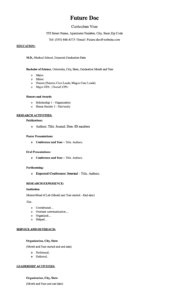Building Your Medical CV: Tips for Medical Students
- by
- Aug 31, 2023
- Reviewed by: Amy Rontal, MD

Your Curriculum Vitae (CV) is a document that summarizes all of your professional achievements in an efficient and easily accessible manner. It’s an essential component of your residency application and something that program directors will take a good look at, so you want to be sure it’s up to their standards.
Due to the importance residency programs place on this document, students often struggle building their medical CV and figuring out what to include. If you’re having some CV-related stress, don’t worry! In this post, we’ll give you some tips for building your medical CV and share a sample document to help you format your own.
 Approaching residency applications? Download the FREE Residency Application Timeline to stay on track throughout M3 and M4 year!
Approaching residency applications? Download the FREE Residency Application Timeline to stay on track throughout M3 and M4 year!
How to Build a Medical CV as a Med Student
The Components of a Good CV
The Header
First, the header of your CV should include your name prominently displayed, your address, your phone number, and an email. This email should be the one email you use for all residency application communications.
Education
The first main section of your CV will be about your education. This section should be in reverse chronological order, from most recent to oldest. It includes your MD/DO expected graduation year, any graduate programs such as MBA/MPH etc, and your undergraduate institution.
You can also mention any honors or awards you received during college and medical school, such as special scholarships and honors society memberships. These can be listed in a separate portion of the education section if you prefer.
Research
The second main section of your CV should detail any research or scholarly activity you’ve engaged in. Residency program directors are especially interested in this portion of your CV—scholarly activity is how we push medicine forward and helping with that push makes you a better scientist, physician, and consumer of medical literature.
This section should list every paper, post, oral presentation, abstract, and case report you wrote or helped write. Again, these should be listed in reverse chronological order. Be sure to include the authors, title, journal name, date, volume, issue, page number, and any identifier numbers available as if you were writing a bibliography. Additionally, it’s best to break your research down into subsections based on type. For example, you’ll have a section for papers, posters, oral presentations, etc. (in that order).
Finally, you should have a subsection for forthcoming work. This is where papers that you’ve submitted but are still under review and those you are almost done writing and are about to submit should be placed.
Research Experience
Section 3 of your CV is kind of an extension of section 2. This is where you list your research experiences. Here you can note where you did your research and who you did it with. Were you a lab assistant at the NIH? A research coordinator within a department? You should list these experiences as if they were jobs, and be sure to describe exactly what you did!
The ideal way to write these experiences is with past tense action verbs such as “conducted,” “performed,” and so on. This will be demonstrated in the sample CV format at the end of this blog.
Service and Outreach
Section 4 of your CV is all about service and outreach. Part of being a great physician is selflessly serving your community. The way you demonstrate the capacity to serve to a potential residency program is to engage in service and outreach activities during medical school and even college.
The key here, however, is that these should be activities you are truly passionate about, and not just things you did to fill up this section of your CV. You’ll be asked about these activities during interviews, and you must be able to talk about them thoroughly. This tip goes for everything on your CV, by the way, but it’s especially true here.
Leadership Activities
The final section of your CV is for leadership activities. If you were the club president, a service chair, or vice president of a club during college or medical school, this is your chance to showcase it. Be sure to include the organization name, position, timeframe and description of what you specifically did. Your description should be in bullet point format (as you’ll see with the format sample), with the same action verbs used.
Putting It All Together
As a few final pointers: on your CV, your descriptions shouldn’t be concise—they should explain who you are and what you’ve done so a program director can get a sense of why you’d be a good match for their residency program. You don’t want to be too generic, or for that matter, too repetitive.
Get out a thesaurus and use some unique words to avoid repetition. Overall, your CV should be easy to read, consistent in font and size, and not too flashy. Include only things you can describe in detail from memory that had a significant impact on your life.
Here’s the sample CV format we mentioned at the beginning of the blog, which illustrates and summarizes much of what we’ve been discussing:
 We wish you the best of luck while building your own medical CV! For more professional development tips from Blueprint tutors, check out these other (free!) articles on the Med School blog:
We wish you the best of luck while building your own medical CV! For more professional development tips from Blueprint tutors, check out these other (free!) articles on the Med School blog:
About the Author
I am a graduate of the Ohio State University with a degree in Neuroscience as well as a minor in clinical Psychology. I am currently a research coordinator at University of Pittsburgh Medical Center prior to beginning residency. I am attending the University of Pittsburgh Medical School for my MD. I am interested in the field of Orthopaedics as well as medical education, healthcare reform, and various advocacy groups. I focus on questions/testing strategy as well as taking what you learn from a book and applying it to test questions. Twitter: @LCluts









